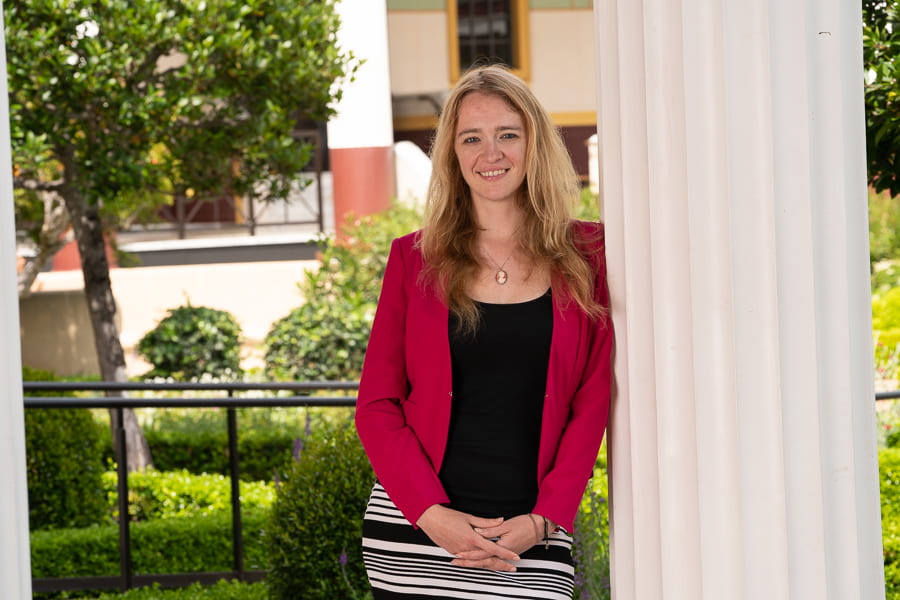Even when dealing with the most solid of objects, UNE archaeologist Dr Alina Kozlovski loves the way history can throw up curly questions.
Alina has been all over the world in pursuit of the past – she’s excavated in Tuscany, Sicily and Cyprus, and lived and worked in Italy, the UK and the US. She’s worked with fragile papyri preserved at Herculaneum – a city swallowed up alongside Pompeii in the famous Mt Vesuvius eruption – and with nuclear scientists to learn about ancient Chinese ceramics. She’s curated displays at museums around the world, even remotely. Recently arrived in Armidale from Sydney, she has a soft spot for the Powerhouse Museum and its eclectic collection.
But for Alina, it’s the challenge of telling stories about the past that keeps her interested. It’s why she particularly loves Greco-Roman history.
“Greek and Roman culture has been studied throughout history all over the world – from medieval Europe to colonised America – so it has a complicated, layered story. That world of responses in between then and now affects the way we understand that context,” she says.
That layered story gets even more complicated – and the questions even curlier – when looking at digitised objects, which will be one of Alina’s focuses as a Lecturer in Digital Innovation (Ancient History and Archaeology) at UNE.
Models throw new light on historical objects.
“Models of objects create different notions of authenticity. The reproducibility of models, whether digital or not, for example, means people react differently than they would when viewing an ‘original’ object. They throw up questions like, can I trust a reconstructed model? What can a model contribute when I can see the original object? What extra questions can it make us ask about the original?
“There are still human choices to be made when digitising an object too – digitising doesn’t make a perfect copy. We could ask what’s the point of making them then, or we turn that facet of models into something productive for thinking about how we study the past.”
Alina says a digitised model could also impact an object’s perceived purpose and value.
I hope to work with the collections here and help facilitate their use in teaching. I’d love to look at finding interdisciplinary links and exciting ways of using different collections together. I think, coming from museum roles, that’s an area to which I can contribute.
“Objects in a museum usually have specific rules for how you can engage with them, whether because of particular cultural associations or because of their physical fragility. But digitised objects can sometimes be a free for all – should they have rules for how they are treated and ‘handled’, too?
“There’s also tension in the way digital things are portrayed as something that lasts forever, but often they get created and disappear, such as on a defunct website. So we have to ask, what will actually last? Can you have an archaeology of digitised artefacts and their ‘sites’ as you would with material ones?”
Bringing these philosophical and ethical questions to the fore is one of the things Alina’s looking forward to in her role at UNE when she steps into the classroom next trimester, teaching Roman History. That, and getting involved in UNE’s many artefact collections.
“I hope to work with the collections here and help facilitate their use in teaching. I’d love to look at finding interdisciplinary links and exciting ways of using different collections together. I think, coming from museum roles, that’s an area to which I can contribute.”
Dr Alina Kozlovski comes to UNE from the Santa Barbara Museum of Art, with a PhD from the University of Cambridge on Roman approaches to the material past. She has held postdoctoral research fellowships at the British School in Rome and the Museum of Applied Arts and Sciences (Sydney) and is an award-winning teacher and a recognised expert in material culture methodologies. She has considerable experience in the application of digital formats and technologies, including collaborative work with UNSW’s Expanded Perception & Interaction Centre.



Dearest Alina,
I have followed your career and now love the fact that you are at UNE my Alma Mata. I literally burst with pride at all you have achieved. I promise I will continue to follow.
Love
Pamela
Love your approach to objects, models and digitisation. And what a career! Looking forward to seeing what you achieve at UNE.